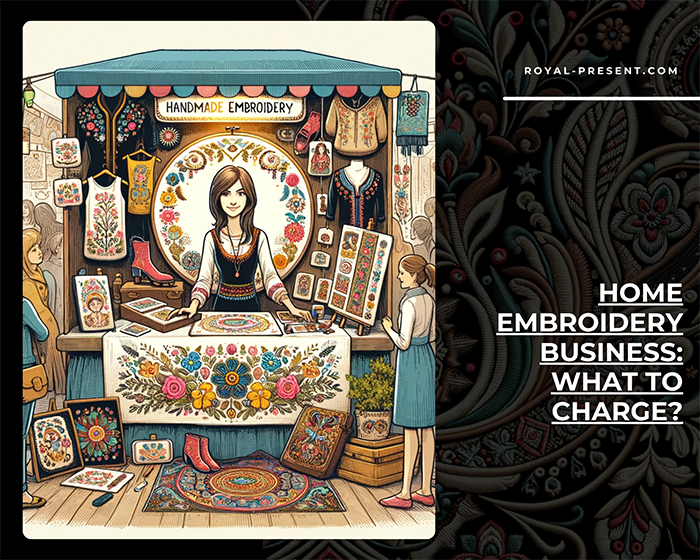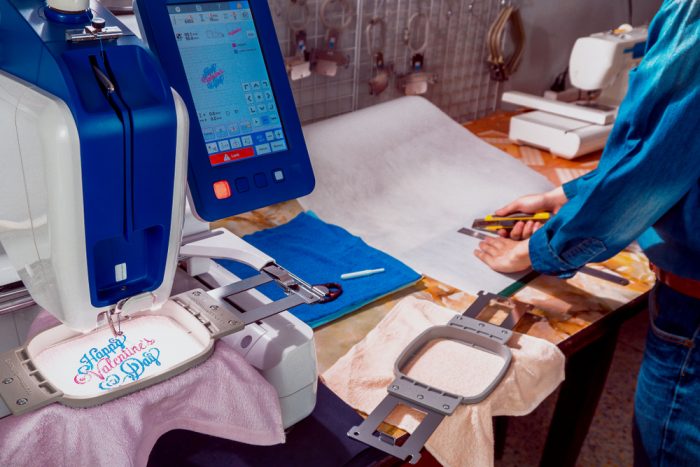
So you’re set upon taking your hobby up onto the professional level to get some extra income or even switch to it as to a full time occupation. In order to succeed in your endeavor you need to have many things figured out. Equipment, supplies, venue, clients, orders – the list of such things is quite large indeed, but, remember, you’re building a business. And the main goal of your home embroidery business is generation of profit. The profit will come, of course, from orders, and you need to know how to price them right. “Home embroidery business: what to charge?” will try to help you get answers to main questions, regarding the issue. The article will address such questions as “What the price of embroidery is comprised of?”, “How to figure it out?” and the like. So are you ready to charge? Then, let’s begin our tale.
First of all, let’s make it clear that all the given information is not a strict rule, but more of a guide line to build your pricing policy upon. Its aim is to give everyone who starts a home embroidery business a general understanding of what their profit will come from. Take this knowledge and hopefully it’ll help you to build a thriving business for you and your family. So, now that we’ve cleared it out, let’s further into the subject.
What is the right price for embroidery?
The price of embroidery, be it a product (e.g. embroidered pillow) or services (e.g. decorative cover of holes and tear), is a sum of many little and BIG things. Some of the things are fixed (expenses on your embroidery machine), others are variable (expenses on supplies). When charging a certain price you should remember the following things:
- The “right” price should be beneficial for the business, but should not scare your clients away.
- It should cover all the expenses, your time included.
- It should allow your business to grow.
Now, that we’ve settled it, let’s see what the right price is comprised of. Here’s the list of the things:
- Design cost,
- Supplies (stabilizers, threads etc.) expenses,
- Embroidery machine expenses,
- Labor cost (a.k.a your salary),
- Stitches or embroidery machine productivity,
- Extra expenses which might (or might not) occur: taxes, venue expenses (rent, electricity bills, cost of professional software (if you use such) etc.
Now, you see that you have a number of certain things that you spend your money on when you make an embroidery product. What you have to do with the list is to find out the average cost of each of its items and then sum all of them up. With some of the lots it’s quite plain and simple. The other, well, require some math.
Home embroidery business what to charge
Designs. Cost-wise you’ll be dealing with 3 categories of embroidery designs:
- Free embroidery designs (come with the machine or from free downloads from elsewhere),
- Designs that you bought (from an online shop or a designs maker),
- Designs that you make yourself (digitize).
Calculating design costs definitely requires some math. But don’t worry; we’ll try to make it as simple as possible. Basically, if you spend money or time on a design, you need to add the cost to the price of the order. The more you spend, the pricier is an order. As on digitizing you spend the most of both, it involves higher expenditures. Thus orders with customized embroidery designs are usually more expensive. Now the topic of what to charge for digitizing is a more intricate one. As a home embroidery start-up, you might never concern yourself with digitizing per se. The most you’ll do is to do some minor changes in the program. This should also be counted as your labor expenses. Otherwise you can set a fixed fee for working with programs (setups).
Supplies: threads, stabilizers, fabric (for appliqués, patches), embroidered-to be pieces (pillows, napkins) etc. Costs of supplies are added to each particular order.
Equipment costs. You’ve invested in an embroidery machine (heat press, computer etc.) and you need to recover those expenses at some point. Set the timeframe for the recovery and the rate which will allow you to pay all the machinery off. This rate will be another fixed cost added to each order you get.
Labor, spent on each order, is usually assessed according to the average labor cost per hour in your location. You should include this item into the fixed costs even if run a one-man home embroidery business. After all, you’re your own employer and employee, so the salary is very important, right?
Stitches or embroidery machine productivity will help you assess your production costs. You must know how much does it cost you to work on your machine. To learn what to charge for your particular machine you should know how many stitches it can sew per hour. The cost of this item will vary depending on what type of machine you’re working on. If you have an industrial, multi-needle machine, you’ll be able to make more stitches per hour during a shift. An average domestic machine sews slower than an industrial one. Thus, judging by the productivity, domestic machines are less profitable or simply put: their stitches are more expensive.
Home embroidery business: what to charge?
Things, to keep in mind when figuring out the stitch productivity: An embroidery machine can sew only so many hours per shift (not the entire shift). You’ll have to stop the machine to let it cool, otherwise it’ll break only too soon. Also, half of the times you’ll have to stitch at a speed slower than your machine’s top speed. So, when making your total on the stitch productivity you need to take into account these points too.
Now, knowing all the above, we can figure out the stitch price using the following formula: all the stitches that your machine makes during its working shift (minus time for the cool-down, hooping and threading) should be divided by the cost of the labor per hour. So, when you’ll get the number, you’ll be able to assess productivity cost of your machine. This cost is added to the final price of the order.
NOTE: You usually hear embroidery businesses base their charges on stitch counts. Stitch price shouldn’t be mistaken for the entire price of the order. It’s only a way of estimating the real cost (mind: not the price, but the cost) of embroidery production. What’s more, stitch count approach isn’t the most accurate one. To make your assessment of what to charge be more accurate, you need to take into account a lot more than just stitches.
Example 1: Order: appliqué with several hooping and thread-changes, Machine: single needle, domestic. What will you charge? Stitch count will give too low of a price, thus you need to make adjustments. Which? The answer is simple: use same formula but double or triple (depending on the circumstances) your labor costs.
Adjustments of such kind will always be present when you’ll be working with orders of different types.
Example 2: Metallic-thread embroidery will cost more not only because the thread itself is expensive. Also, metallic threads take quite a toll on the equipment, causing you spend more on the service. Thus, you will have to make according adjustments to the final price.
Example 3: Another great case to look into is how to charge single orders for simple embroidery with only few stitches. In this case the cost of your labor will make up the most part of the price. So, to make things simpler both you and the client, have a set price for orders of such “small-scale” type.
NOTE: At the very beginning, you’ll be probably dealing with orders of this kind only. It’s not bad, as you’re only establishing your business. Later, however, when there’ll be a constant flow of other, more profitable orders, you should re-think your charging policy again.
Extra expenses which might (or might not) occur: taxes, venue expenses (rent, electricity bills, cost of professional software (if you use such) etc. As you must to cover all them, you need to make it part of the embroidery cost.
So now you know that in order to charge the right price for your work (embroidery service or product) you need to take into account all of the 6 aspects of the present costs list. Are you thinking yet that maybe you should go to college and get a degree to actually manage setting the right price for your embroidery? Don’t be, it’s easier than it sounds. In the beginning, especially if we’re talking about home-run embroidery business with a domestic embroidery machine, you probably won’t even have to get into such accounting minutes. You’ll just compare to what your competition charges and act along their lines. In the very beginning this charging policy is ok. As your business grows, you’ll learn to assess each of the items of the list, we mention. It’ll become more understandable and easy to use.
TIP: There’re lots of online tools, which can make embroidery charges calculations a piece of cake. Just google “embroidery pricing calculator”, “cost analysis chart/worksheet” and enjoy. Besides online tools, there’s also software, which can help manage your charging strategies.
That being said, it’s important to mention, that there’re other formulas of embroidery price calculations. Some of them will include counting not only stitches, but also thread changes. Charging policy can also vary from business to business. Some prefer make such calculations for each particular order, others use pre-set prices for their units. It’s up to you which of the methods you will use.
In conclusion, establishing the right pricing strategy for your home embroidery business is crucial for its success and sustainability. This article has aimed to demystify the process, breaking it down into manageable components: design costs, supply expenses, equipment costs, labor, stitch productivity, and additional expenses like taxes and utilities. While the initial approach might involve aligning your prices with market standards, as your business evolves, a more nuanced understanding and application of these pricing components will become essential.
Remember, pricing is not just about covering costs; it's about valuing your time, skill, and the unique services you offer. It's also about understanding your market and positioning your business competitively. As you gain experience, you'll find that tailoring your pricing to the specifics of each project, while sometimes complex, will yield more accurate and profitable outcomes. Tools like online calculators and specialized software can significantly simplify this process.
Ultimately, effective pricing is a balance between fairness to your customers and ensuring the financial health of your business. It's a dynamic process that will evolve with your growing experience and changing market conditions. Embrace this learning curve and let your pricing strategy be a reflection of both the quality of your work and your understanding of your business's worth.
You may also like

Author: Ludmila Konovalova
My name is Lyudmila Konovalova, and I lead Royal Present Embroidery. Embroidery for me is more than a profession; it is a legacy of my Ukrainian and Bulgarian heritage, where every woman in my family was a virtuoso in cross-stitch and smooth stitching. This art, passed down through generations, is part of my soul and a symbol of national pride.
Date: 25.12.2023






 Get Sign-In Link
Get Sign-In Link Login with Google
Login with Google Login with Facebook
Login with Facebook Login with Amazon
Login with Amazon Login with Paypal
Login with Paypal